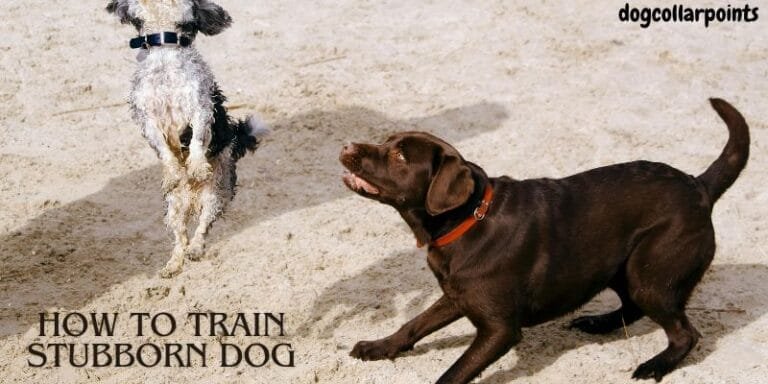How To Use Shock Collar For Dog Training – Guide

Training a dog requires patience and consistency, but sometimes certain behaviors need to be addressed immediately. This is where shock collars can be effective tools for dog training. While some people view them as controversial, when used properly, shock collars can be humane and efficient in correcting unwanted behavior.
In this guide, we will discuss how to use shock collar for dog training, ensuring that your furry companion learns to obey commands and becomes a well-behaved member of your household.
How To Use Shock Collar For Dog Training step-by-step Guide
1: Choose the Right Shock Collar
When choosing a shock collar, it is important to consider the size and temperament of your dog. Make sure to select a collar with adjustable settings and choose one that is appropriate for your dog’s weight. It is also recommended to consult with a professional trainer or veterinarian before purchasing a shock collar.
2: Familiarize Your Dog with the Collar
Before putting the collar on your dog, let them sniff and examine it. This will help them become more comfortable with wearing it.
3: Start with a Low Level of Shock
Once your dog is familiar with the collar, start with the lowest level of shock and observe their reaction. You want to find the lowest level that is effective in getting your dog’s attention.
4: Use Positive Reinforcement
In addition to using the shock collar, it is important to use positive reinforcement as well. Praise and reward your dog when they follow commands or exhibits good behavior.
5: Be Consistent
Consistency is key when using a shock collar for training. Make sure everyone in the household is on board with using the collar and that commands are given in a consistent manner.
6: Use the Collar as a Last Resort
Shock collars should only be used as a last resort for correcting unwanted behavior. They should not be used for punishment or to replace proper training techniques.
7: Gradually Decrease the Use of the Collar
As your dog becomes more responsive to commands and exhibits good behavior, gradually decrease the use of the shock collar. Eventually, you may be able to stop using it altogether.
How Does a Shock Collar Work?
A shock collar works by delivering a static shock to your dog’s neck when activated. The intensity of the shock can be adjusted depending on the size and temperament of your dog. Many collars also have different modes, such as vibration or sound, which can be used instead of or in addition to the shock function.
When you press the button to activate the shock, it sends a signal to the collar, which then delivers the static shock. This acts as a deterrent for unwanted behavior and can be used in conjunction with verbal commands.
It is important to note that shock collars should not be used for extended periods of time, as they can cause discomfort or even injury to your dog. They should only be used during training sessions and under the guidance of a professional.
Overall, shock collars can be effective tools for dog training when used properly and with positive reinforcement. They should always be used as a last resort and never as a replacement for proper training techniques and consistency. With patience and dedication, you can effectively use a shock collar to train your dog and improve their behavior.
So, it is important to follow the steps carefully and always prioritize your dog’s safety and well-being. With the right approach, a shock collar can be a helpful tool in creating a strong bond between you and your furry friend. Happy training!
How to Properly Train a Dog with a Shock Collar?
Proper training with a shock collar involves more than just putting the collar on your dog and pressing a button. It requires patience, consistency, and understanding of your dog’s behavior.
First and foremost, it is important to identify the behaviors you want to correct using the shock collar. This can include things like excessive barking, jumping on furniture, or chasing after other animals. Once you have identified the behaviors, make sure to provide clear and consistent commands for your dog to follow.
When using the shock collar, it is important to remain calm and assertive. Your dog can sense your energy and will respond better when you are in control of the situation. It is also important to never use the shock collar as a form of punishment or abuse.
This can cause your dog to become fearful or aggressive, which defeats the purpose of using the collar for training.
In addition to using the shock collar, positive reinforcement is key in training your dog. Praise and reward them when they exhibit good behavior or follow commands successfully. This will help strengthen the bond between you and your dog and make training a more positive experience.
What Else Can You Teach Your Dog Using a Shock Collar?
Aside from correcting unwanted behavior, a shock collar can also be used to teach your dog new skills and commands. For example, you can use the shock collar as a tool for recall training or teaching your dog to stay in a designated area.
However, it is important to remember that positive reinforcement should always be used in conjunction with the shock collar when teaching new skills. This will help your dog associate the shock with the desired behavior, rather than fearing it.
Some other skills you can teach your dog using a shock collar include:
- Teaching boundaries and boundaries training
- Training for off-leash obedience
- Agility training
- Hunting or tracking commands
- Swimming or water retrieving skills
It is important to remember that every dog is unique and may respond differently to training with a shock collar. It is important to consult with a professional trainer or veterinarian before using a shock collar for any type of training. With patience, consistency, and positive reinforcement, you can effectively use a shock collar to teach your dog new skills and behaviors. So, don’t be afraid to explore the various uses of a shock collar and see how it can benefit your dog’s training journey. Happy teaching!
Addressing Safety Concerns:
Safety should always be a top priority when using shock collars for training. Here are some safety considerations to keep in mind:
- Proper Fit: Ensure the shock collar fits snugly yet comfortably around your dog’s neck, allowing for proper contact with the skin.
- Regular Checks: Regularly inspect the collar and your dog’s neck for any signs of irritation or discomfort.
- Limited Use: Use the shock collar as part of a comprehensive training program and avoid relying solely on it for behavior modification. Limit the use of the collar to specific training sessions rather than continuous, long-term wear.
Personal Experience:
In my years of working with various dog breeds, I’ve witnessed firsthand the transformative impact of shock collar training when implemented correctly. From curbing excessive barking to reinforcing recall commands, shock collars can be powerful tools in shaping desired behaviors while maintaining a strong bond with your furry companion.
Conclusion
In conclusion, shock collars can be effective tools for training your dog when used properly and with positive reinforcement. However, they should always be used as a last resort and never as a replacement for proper training techniques and consistency.
It is important to take the time to understand your dog’s behavior and use the shock collar only when necessary. Remember to always prioritize your dog’s safety and well-being, and never use the shock collar as a form of punishment or abuse.
With patience, consistency, and positive reinforcement, you can effectively use a shock collar to correct unwanted behavior and teach your dog new skills and commands. With the right approach, you can strengthen the bond between your furry friend and improve their behavior through training. Happy training!
Frequently Asked Questions (FAQs)
Does training a dog with a shock collar work?
When used properly and in conjunction with positive reinforcement, a shock collar can be an effective tool for training your dog. However, it should always be used as a last resort and under the guidance of a professional trainer or veterinarian.
How do you start training a dog with a shock collar?
Before starting training with a shock collar, it is important to identify the behaviors you want to correct and provide clear and consistent commands for your dog to follow. It is also crucial to understand your dog’s behavior and use the shock collar only when necessary.
When should you start using a shock collar on a dog?
Shock collars should only be used on dogs after all other training methods have been exhausted and under the guidance of a professional trainer or veterinarian. Additionally, it is important to ensure that your dog has reached an appropriate age and size for the use of a shock collar.
How do you get a dog to come when called with a shock collar?
Positive reinforcement should always be used in conjunction with the shock collar when teaching your dog to come when called. This will help your pet associate the shock with the desired behavior, rather than fearing it. It is also important to practice consistency and patience during training. So, use clear commands and reward them for following them successfully.






